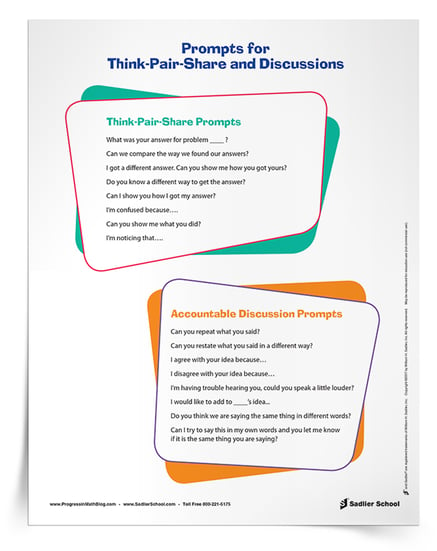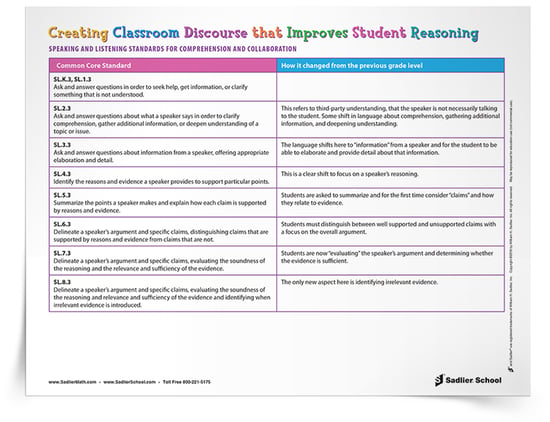February 19, 2025 other-professional-development
How to Improve Mathematical Discourse in Your Classroom
By: Jeff Todd
It has been difficult for me to learn how to stimulate vibrant discussions about mathematics among students. I realized very early in my teaching career that in order to get students engaged in mathematical discourse I needed to foster community in the classroom, help students feel safe expressing ideas, and demonstrate that math can be fun!
In this article, discover strategies to enhance student interaction, plus download a set of prompts to support productive math discussions in your classroom.
Download the Creating Classroom Discourse that
Improves Student Reasoning Chart now.

What is Mathematical Discourse?
Mathematical discourse refers to the meaningful conversations students engage in to discuss, reason, and solve problems in mathematics. It’s more than just talking about math—it involves analyzing ideas, explaining reasoning, critiquing the reasoning of others, and building a shared understanding of mathematical concepts.
Throughout my teaching career, I've learned that fostering mathematical discourse doesn't happen overnight. Each semester, I meet students from varying backgrounds—some have been in teacher-directed classrooms where discussion wasn’t emphasized, while others have limited practice articulating their mathematical thinking despite exposure to discourse.
So how can educators improve and promote meaningful mathematical discourse in their classrooms?
How to Improve Mathematical Discourse in the Classroom
Step 1: Review the Importance of Mathematical Discourse
Participating in mathematical discourse has long been identified as an essential component of students' mathematics learning. In fact, being able to communicate mathematics is so important it is included in both the Common Core State Standards and The National Council of Teachers of Mathematics Principles and Standards for School Mathematics.
When students engage in conversations, what they say reveals a number of things. It exposes their level of understanding about a mathematical topic. It shows whether they can listen to and react to their classroom colleagues—a critical skill for their future workplaces. It helps them learn to develop arguments, one of the key standards for mathematical practice. And it gives you, the teacher, valuable information about where they might be struggling.
To promote quality mathematics discussions, students need to understand why discourse is important.
Students need to be reminded that communication is helpful for understanding mathematical concepts. They need reassurance that although it can be unnerving to participate in discussions about mathematics, it is beneficial to their learning!
Step 2: Establish a Community
Establishing a learning environment that welcomes student involvement is the key to engaging students in discourse.
First and foremost, it's important to create an atmosphere where students are celebrated for their inquiries and are encouraged to comment. If students know the classroom is a safe space to communicate in, they will be more willing to discuss math with their peers during discourse.
Additionally, teachers need to promote a learning community where students are active listeners. Active listening is an important component of any classroom, but in the math classroom it is crucial to comprehension! Without active listening, students will not be able to critique the reasoning of their peers or analyze how their understanding aligns with or differs from their classmates.
Finally, teachers need to set the expectation that every student will contribute during math talk. Establishing expectations emphasizes that the class is a community of learners. They are all in it together!
Step 3: Facilitate Student Interaction
Simply posing a question that encourages discussion does not guarantee successful math talk. Mathematical discourse begins with student interaction.
The goal of teaching students to interact in pairs, in small groups, or as a whole class is for students to be able to construct viable arguments and to critique the reasoning of others which is Standard for Mathematical Practice 3.
The ability for all students to reach high levels of reasoning for all students is greatly enhanced by training students to have good peer and class discussions.
Students need exposure to their peers’ reasoning. They also need low-risk opportunities to practice their own reasoning in pairs or small groups. These opportunities reach their pinnacle when students can have dynamic whole class discussions.
Here are some helpful ideas to improve student interaction!
How to Promote Mathematical Discourse in the Classroom
Promote Interaction When Students Work in Pairs
Think-Pair-Share is a staple of American pedagogy. Pairing students in order for them to discuss mathematics accomplishes many objectives. One of the most important objectives is that students get to “rehearse” their responses. Students sometimes don’t want to share their ideas in class because they aren’t sure how to phrase their thoughts. Perhaps they are not sure whether their responses are valuable or correct. By first sharing their ideas with a peer, they can get an initial reaction and sharpen their response if called on to share with the class.
One thing I do when I want to help students to have better interactions in pairs is to provide sentence frames or scripts for their conversations. Especially if students have little experience in discussing math with partners in the classroom, I might give them a simple script for comparing their answers on last night’s homework. For example, you could share these prompts with your students:

I used to think that students could naturally have conversations like this. However, without training, many students will not do this on their own. I usually also train students to thank each other for their help or to say something like: “Great job,” “Thanks for your help,” or “That was a great way to find that answer.”
Promote Interaction Among Students in Classroom Discussions
The most important thing I think I can do with my students is to hold them accountable during classroom discussions. One way to do this is with accountable discussion prompts. This is a big investment at first, but the long-term dividends are great!
First, students are accountable for listening. I make sure students understand the importance of tuning into the class discussion. Using popsicle sticks, dice, index cards, or some other random way to call on students, I have students repeat what they have heard other students say regarding the topic. I encourage them to reiterate specific points. This promotes active listening.
Second, students are accountable for speaking. During the listening exercise, I also take the opportunity to highlight the importance of speaking up when addressing a group of people. Sometimes students who don’t speak very loudly need to project their voices more because students on the other side of the classroom are not able to hear them. Reserved students might need some prompts such as: "Could you repeat that for me?" or, "I’m sorry I couldn’t hear you, could you speak up a little?"
Finally, students are accountable for sharing. Once you are confident students are tuning into the class discussion, you can ask them to agree or disagree with each others’ ideas, add on to or continue a thought, or bring up a new point.
What to Expect From Students
Pulling this all together in the classroom might seem overwhelming, especially if you are new to integrating discourse into your classroom routines. But you shouldn’t the only one doing this, as developing great student discourse should be a goal of every teacher in the building. If you are teaching only math or just math/science, then you should tap into your network of ELA counterparts to help you.
Speaking and Listening Posters
Speaking and Listening standards provide a jumping-off point for you as the teacher to know what is expected for classroom conversations for any grade level from Kindergarten to Grade 8. It sets a course for the incremental development of students listening and speaking skills.
The Speaking and Listening Posters provide tips for being an active participant and can be given to each student or posted in your classroom.
Creating Classroom Discourse Chart
As you are planning your lessons, you can use this downloadable chart to help you identify Speaking and Listening standards to improve reasoning in your classroom discourse for each grade level.
This chart shows the increasing sophistication that students should have in reasoning and argumentation at each grade level in the two standard clusters, Comprehension and Collaboration as well as Presentation of Knowledge and Ideas. For both clusters, it lists the standard numbers, the actual standards, and how the standard has changed from the grade level before. That allows you to hone in on exactly the facet of communication that you want your students to develop.
If your supervisor or coach is looking for “language standards” as part of your lesson plan, these would fill that need. This download will also be very helpful at your professional development meetings across content areas.
In Summary
If you are learning how to foster great student discussions in your math class, these ideas will help your students to engage with each other. To successfully engage students in mathematical discourse teachers need to foster community in the classroom, help students feel safe expressing ideas, and demonstrate that math can be fun. Although it's ideal to implement best practices for math talk at the beginning of the school year, it is never too late to improve math discourse in the classroom.
Download a series of prompts you can use to improve student interaction in your classroom.







